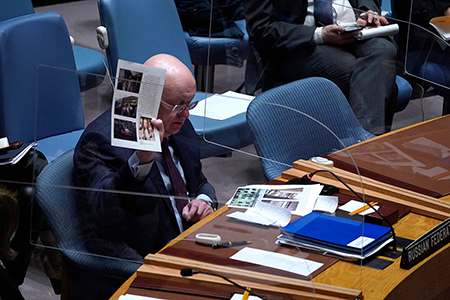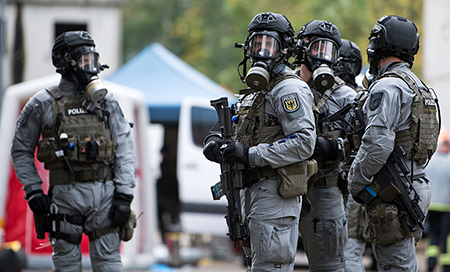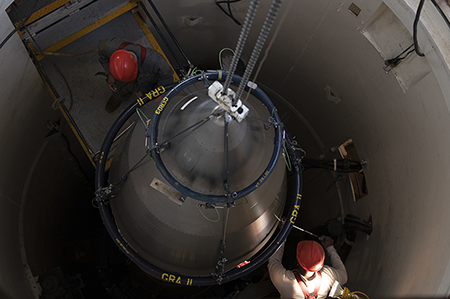December 2024
By Jez Littlewood and Filippa Lentzos
By the end of this month, states-parties will be halfway through their latest attempt to strengthen the Biological Weapons Convention (BWC). This effort was launched in 2022 at the convention’s ninth review conference with the establishment of a working group to “identify, examine and develop specific and effective measures, including possible legally binding measures, and to make recommendations to strengthen and institutionalize the Convention in all its aspects.”1

The working group was tasked with addressing seven areas: international cooperation and assistance, scientific and technological developments relevant to the convention, confidence building and transparency, compliance and verification, national implementation, assistance, response and preparedness in the event of use of biological or toxin weapons, and organizational, institutional, and financial issues. States-parties also decided to develop two mechanisms to support the BWC: one to review and assess scientific and technological developments and provide advice to states-parties on their implications and the other to facilitate and support international cooperation and assistance under BWC Article X, which covers peaceful uses of biology. Both mechanisms would be developed by the working group, which would make recommendations to states-parties.
The working group was given 60 days (15 days a year over four years) to make recommendations to strengthen and institutionalize all aspects of the BWC. How to best accomplish this has been contentious throughout the treaty’s nearly 50-year history. Most of the topics have been explored previously, with states-parties failing to reach consensus on advancing more robust transparency, cooperation, and compliance procedures. Now it is being done again in a period of particularly fraught geopolitical relations.
Substantial progress has been made in some areas, but beneath the surface is a broader conflict about the shape of arms control agreements generally. This raises a question about whether strengthening the BWC needs to follow the traditional model of legally binding multilateral agreements with declarations, inspections, investigations, and an international organization where consensus rules or whether states-parties can agree to a new model that allows states to opt in to the mechanisms with which they agree and opt out of any processes or new commitments they are unable to support.
The Working Group
Perhaps the most interesting aspect of the working group agenda was the inclusion of verification and compliance issues as topics for discussion. Their inclusion raised the possibility of legally binding measures similiar to the protocol on verification provisions from the 1990s.
Since 2001, when negotiations on a verification protocol collapsed, multiple events have influenced how states and civil society think about the BWC, its weaknesses, and ways to strengthen it. These include the 9/11 terrorist attacks, the anthrax letters targeting media outlets and politicians shortly after those attacks, the Iraq war, and the Organisation for the Prohibition of Chemical Weapons (OPCW) response to Syria’s use of chemical weapons. In addition, there have been fears of terrorist groups acquiring biological weapons, significant scientific and technological developments that have lowered the barriers to biological weapons development for nefarious actors, the COVID-19 pandemic, Russia’s rejected allegations of offensive biological weapons activity by the United States and Ukraine, and changing attitudes toward arms control and disarmament.
The first session of the working group, in March 2023, organized the group’s 60 days of work on a schedule that would include 10 days focused on compliance and verification; eight days each on international cooperation and assistance and scientific and technological developments; seven days on assistance, response, and preparedness; five days each on confidence building and transparency and national implementation; four days on organizational, institutional, and financial issues; two days on each of the mechanisms; four days to consider issues related to all topics; and five days to complete any leftover work and write the report. To date, more time has been spent on cooperation issues and scientific and technological development compared to compliance and verification and other areas. As a result, compliance and verification issues are more conceptual but a new working paper by the United States and six other states-parties is more concrete than anything else put forward for over two decades.2
At this stage, three visions of how to strengthen the BWC are emerging. The first is a traditional arms control approach centered on a multilaterally negotiated, legally binding verification treaty, essentially a return to the protocol debated in the 1990s. The second is a pragmatic approach that embraces the working group’s task to explore and make recommendations that fulfill the objective of strengthening the effectiveness and improving the implementation of the BWC. The pragmatists are not prejudging how to achieve that objective. It may involve a range of approaches and could include a legally binding component. The third approach is incremental and suggests a way forward that is built on a series of actions and activities completed by states-parties in different ways that cumulatively move BWC implementation forward through national, bilateral, and multilateral approaches. Although multilateralism is one component of action, states can pursue other approaches outside the convention.
The Traditional Approach
For a few states-parties, the weaknesses of the BWC are mainly if not completely the result of the U.S. decision in July 2001 to reject the draft version of the verification protocol. China, Iran, and Russia are the dominant voices advocating for a traditional approach to strengthening the BWC, as they have been for most of the last 20 years.
Each state has a slightly different emphasis, based on their formal proposals reflected in working papers. For Iran, the dominant issue is peaceful cooperation and technology transfer, and its main target is sanctions; anything other than a legally binding agreement is insufficient. China’s starting point is to review the work on the protocol completed in the 1990s to assess its applicability to any future negotiations.
Of the three, Russia seems most determined to live in the past, having resurrected its previous proposals for agreed definitions and terminology, lists of pathogens and equipment that are relevant to offensive biological weapons activity, and quantitative and material accountancy approaches to determine compliance.3 Quantitative approaches to determining compliance with Article I of the BWC are anathema to most Western states-parties because the convention prohibition hinges not on specific things or identified amounts, but on the purpose for which something is being used. Material accountancy approaches will not work in the BWC.
Although it would be incorrect to characterize everything espoused by China, Iran, and Russia as unhelpful, each has a vision of a strengthened convention that places consensually agreed-on procedures, mechanisms, and approaches as the only way to determine confidence in compliance. Mechanisms outside the convention are irrelevant to their vision of a strengthened BWC: only states and what states want are relevant.
The Pragmatic Approach
The pragmatic approach is apparent in the wide variety of states-parties that are focused on the task of the working group and using its meetings to find ways to strengthen the convention. A legally binding approach is favored by many but not all of these states, and it is not an option that excludes other approaches, at least so far. By identifying ways to improve and enhance implementation of the BWC but not prejudging or committing to how that might be achieved, this approach is allowing ideas to get a fair hearing and have an opportunity to ripen. Importantly, this approach allows for verification to be discussed by states-parties. Because verification has not been covered by the BWC for more than 20 years, the distinctions between verification as an abstract concept and verification as a real, complex challenge is something that requires time and discussion to emerge.

A notable aspect of the pragmatic approach is the groups of states that have come together to advance proposals that cut across the old regional and nonaligned blocs that bedevilled consensus agreement in the past. Denmark, Malawi, Montenegro, Norway, Panama, Singapore, and Uruguay presented a joint paper identifying key considerations in any discussion of verification.4 Georgia, Malawi, Norway, and the Philippines identified five elements that generated broad convergence for a mechanism for international cooperation and assistance.5 Kenya and Panama proposed to strengthen and institutionalize the BWC by enhancing youth engagement, building on the Youth Declaration for Biosecurity.6
Meanwhile, France and India, building on their earlier cooperation from 2018 on a database for assistance under the framework of Article VII, proposed cooperating with the Implementation Support Unit (ISU) on a modular, phased approach to the actual establishment of the database as a working group recommendation.7 The Association of Southeast Asian Nations brought attention to regional cooperation under its chemical, biological, and radiological defense experts group and with other international organizations and bodies such as the UN 1540 Committee.
Emphasizing cooperation with other international actors is a second aspect of the pragmatic approach. In papers presented to the working group by states that cut across traditional interest blocs, scores of entities, including the World Health Organization, the Food and Agriculture Organization, the World Organisation for Animal Health, the European Union, and the Global Partnership Against the Spread of Weapons and Materials of Mass Destruction, have been identified as relevant to the future strengthening of the BWC.
The Incremental Approach
The incremental approach can be discerned not by what it stands for but what it is opposed to: a single, legally binding instrument as the only way to strengthen the convention. States in this camp tend to focus on existing approaches that can be improved rather than new initiatives. They tend to identify what exists in the BWC or outside of it that is relevant as examples for moving forward. Predominantly, they include the United Kingdom, the United States, and the EU, but as with the pragmatic group, there is no single vision on which they all agree.
Opposition to the single, legally binding instrument does not mean rejection of any legally binding mechanisms. The EU and its member states said they could envisage national declarations consistent with existing BWC confidence-building measures.8 This was similar to the U.S. proposal for the working group to consider measures to achieve consistent implementation of the confidence-building measures and how to transform any of them into annual, legally binding declaration requirements.9
Similarly, the United States and the EU noted the need for an investigation process and the possibility of other special measures to address serious suspicions of violations. For the EU, this would be a challenge or special inspection component with strong links to the UN secretary-general mechanism. The United States also identified a certified network of laboratories, possibly in partnership with the OPCW given the toxins overlap, as an option for consideration.
Another aspect of the incremental approach is a focus on strengthening national implementation and enhancing the institutional mechanisms of the BWC. For the UK, compliance depends on effective implementation at the national level and other domestic measures.10 Many of these approaches are evident in the new paper outlining the possible functions of a new BWC implementation organization submitted by the United States and six co-sponsors, including on-site familiarization visits to maximum containment laboratories, technical assistance, more effective national implementation, and enhanced international cooperation as ways to institutionalize implementation.
International cooperation plays an important role in the vision of the future convention for these states, but it should be realistic and focus on what works in the real world rather than traditional concepts of what multilateral verification looked like in the 1990s.11 In this category, ongoing practices such as the Global Partnership, which has launched more than 311 projects valued at more than $1.6 billion and funded by more than 20 states since 2016, can be the basis of improvement.12
Mechanisms as a Foundation
Although ongoing discussions in many areas are overly conceptual, the mechanisms are developing at a quick pace. Friends of the chair groups aligned, respectively, with the international cooperation and assistance and the science and technology mechanisms issued nonpapers to stimulate additional thinking during July and August. One idea with wide support is that the mechanisms could be a foundation and catalyst for additional action going forward. If agreed, they could set a cadence of future annual meetings and activity that would be focused and directly relevant to strengthening the BWC.
In the nonpapers, the mechanisms are structured as being open to all states-parties while a smaller group of representative states-parties would conduct more focused work. The proposed international cooperation and assistance program would be overseen by a steering group and supported by a newly created assistance fund. The steering group is expected to have up to 21 state-party members who reflect a broad geographic distribution and gender balance. In contrast, the proposed science and technology advisory board would work with an advisory group, which is open to all states-parties; a subcommittee of up to 30 members; and temporary working groups to focus on areas where specific technical expertise is required.
The nonpapers call for six additional staff in the ISU to support work with each mechanism and for additional meeting time for their respective areas. The additional costs will be met by increasing the assessed contributions of states-parties. Building on working papers from a variety of states, the international cooperation and assistance mechanism would fund projects based on requests that outlined the objectives, intended outcomes, proposed timelines, and the resources required to implement and sustain the projects.13 There also would be a co-pay element, with most of the states that request assistance providing 15 percent of the costs. Projects would be supported by a voluntary trust fund.
For the science and technology mechanism, the focus is not solely on the risks posed by scientific and technological developments, but also on the opportunities they present to strengthen BWC implementation. As such, there is a complementary and potentially synergistic aspect to the mechanisms. It is possible to envisage a promising science or technology development that has the potential to strengthen implementation of the BWC being identified and assessed by the science and technology mechanism and then funded as a pilot project under the international cooperation mechanism. Assuming some level of success that is identifiable, scaling up the adoption of that innovation becomes an option that any interested state-party might pursue, perhaps with additional funding from other organizations. Much is still to be decided in both mechanisms, but each is sufficiently well developed that the working group potentially could deliver early in 2025 on at least one of its core objectives: recommendations on the establishment of two new BWC mechanisms.
Challenges Ahead
The task before the working group is complex, and it will be easier to fail than succeed. The challenges include some issues of substance, many issues where flexibility will be required, and the securing of a commitment by all who want to strengthen the convention to spend more time and significantly more money to achieve their stated objectives.
One issue of substance is the legally binding approach. If the failed 2001 protocol or some new variant of it as a single, legally binding instrument is the only acceptable way forward for a few states-parties or if any legally binding measure is unacceptable to a few other states-parties, this impasse likely will doom any chance of a consensus report on recommendations.
Flexibility will be required in how the mechanisms are finalized. The international cooperation mechanism is more focused and pragmatic than the traditional open-ended, unspecific calls for more money, more cooperation, and more technology transfers.
A third challenge is money. Some states-parties claim they cannot support any rise in their assessed contributions to offset large BWC budget increases. If that is the case, work may as well end now. There is no feasible way to strengthen the convention without a commitment to more meetings, more institutional support, and more staff for the Implementation Support Unit. A parsimonious approach will not alleviate the BWC weaknesses.
Overall, the working group has made progress, thanks in part to the states-parties that are gravitating to what might be pragmatic and incremental possible solutions rather than what would be ideal. Even if pragmatism and incrementalism wins and the working group succeeds at making recommendations on two mechanisms and on ways to strengthen the convention in seven areas, decisions still will have to be made in 2027 at the 10th BWC review conference. As such, even if the working group succeeds, there remains significant work to be done beyond that point.
ENDNOTES
1. Ninth Review Conference of the States Parties to the Convention on the Prohibition of the Development, Production and Stockpiling of Bacteriological (Biological) and Toxin Weapons and on Their Destruction, “Final Document of the Ninth Review Conference,” BWC/CONF.IX/9, December 22, 2022.
2. Working Group on the Strengthening of the Convention on the Prohibition of the Development, Production, and Stockpiling of Bacteriological (Biological) and Toxin Weapons on Their Destruction,“Possible Structure/Functions of a BWC Implementation Organization: Submitted by the United States of America, Co-sponsored by Australia, Bulgaria, Germany, Slovenia, Sweden, and the United Kingdom of Great Britain and Northern Ireland,” BWC/WG/5/WP.1, November 12, 2024.
3. Working Group on the Strengthening of the Convention on the Prohibition of the Development, Production and Stockpiling of Bacteriological (Biological) and Toxin Weapons and on Their Destruction, “Contemporary Challenges to the Objectives of the Convention on the Prohibition of the Development, Production and Stockpiling of Bacteriological (Biological) and Toxin Weapons and on Their Destruction (BTWC) Related to the Development of Synthetic Biology Technologies and Practical Approaches to Overcome Them: Submitted by Russia,” BWC/WG/2/WP.15, August 7, 2023.
4. Working Group on the Strengthening of the Convention on the Prohibition of the Development, Production and Stockpiling of Bacteriological (Biological) and Toxin Weapons and on Their Destruction, “Key Considerations When Relaunching the Discussion on Verification and Compliance in the Context of the Biological Weapons Convention: Submitted by Denmark, Kenya, Malawi, Montenegro, Norway, Panama, Singapore, Thailand and Uruguay,” BWC/WG/3/WP.8/Rev.1, December 7, 2023.
5. Working Group on the Strengthening of the Convention on the Prohibition of the Development, Production and Stockpiling of Bacteriological (Biological) and Toxin Weapons and on Their Destruction, “Considerations Regarding an International Cooperation and Assistance (ICA) Action Plan: Submitted by Georgia, Malawi, Norway and the Philippines,” BWC/WG/2/WP.22, August 10, 2023.
6. Working Group on the Strengthening of the Convention on the Prohibition of the Development, Production and Stockpiling of Bacteriological (Biological) and Toxin Weapons and on Their Destruction, “Engaging the Next Generation Leaders in Global Biosecurity: Proposals for Strengthening Youth Participation in the Biological Weapons Convention; Submitted by Kenya and Panama,” BWC/WG/2/WP.24, August 18, 2023.
7. Working Group on the Strengthening of the Convention on the Prohibition of the Development, Production and Stockpiling of Bacteriological (Biological) and Toxin Weapons and on Their Destruction, “Proposal for the Establishment of a Database for Assistance Under Article VII of the Biological and Toxin Weapons Convention: Submitted by France and India,” BWC/WG/4/WP.4, August 13, 2024.
8. Working Group on the Strengthening of the Convention on the Prohibition of the Development, Production and Stockpiling of Bacteriological (Biological) and Toxin Weapons and on Their Destruction, “Position of the European Union on Compliance With and Verification Under the Biological and Toxin Weapons Convention: Submitted by the European Union,” BWC/WG/3/WP.17, December 8, 2023.
9. Working Group on the Strengthening of the Convention on the Prohibition of the Development, Production and Stockpiling of Bacteriological (Biological) and Toxin Weapons and on Their Destruction, “U.S. Approach to the Working Group on the Strengthening of the Biological Weapons Convention: Submitted by the United States of America,” BWC/WG/3/WP.9/Rev.1, January 4, 2024.
10. Working Group on the Strengthening of the Convention on the Prohibition of the Development, Production and Stockpiling of Bacteriological (Biological) and Toxin Weapons and on Their Destruction, “Building Global Biosecurity via Confidence in Compliance With the Biological and Toxin Weapons Convention: Submitted by the United Kingdom,” BWC/WG/3/WP.6, November 20, 2023.
11. Working Group on the Strengthening of the Convention on the Prohibition of the Development, Production and Stockpiling of Bacteriological (Biological) and Toxin Weapons and on Their Destruction, “Assistance and Cooperation Under Article X - Background and Options for Consideration: Submitted by the United Kingdom,” BWC/WG/2/WP.2, July 21, 2023.
12. Ninth Review Conference of the States Parties to the Convention on the Prohibition of the Development, Production and Stockpiling of Bacteriological (Biological) and Toxin Weapons and on Their Destruction, “International Activities of Global Partnership Member Countries Related to Article X of the Biological and Toxin Weapons Convention (2017-2022),” BWC/CONF.IX/WP.51, December 6, 2022.
13. Working Group on the Strengthening of the Convention on the Prohibition of the Development, Production and Stockpiling of Bacteriological (Biological) and Toxin Weapons and on Their Destruction, “Proposal for Cooperation and Assistance Mechanism Under Article X: Submitted by Pakistan,” BWC/WG/2/WP.13, August 4, 2023; Working Group on the Strengthening of the Convention on the Prohibition of the Development, Production and Stockpiling of Bacteriological (Biological) and Toxin Weapons and on Their Destruction, “Assistance and Cooperation under Article X - Background and Options for Consideration: Submitted by the United Kingdom,” BWC/WG/2/WP.2, July 21, 2023; Working Group on the Strengthening of the Convention on the Prohibition of the Development, Production and Stockpiling of Bacteriological (Biological) and Toxin Weapons and on Their Destruction, “Considerations Regarding an International Cooperation and Assistance (ICA) Action Plan: Submitted by Georgia, Malawi, Norway and the Philippines,” BWC/WG/2/WP.22, August 10, 2023.
Jez Littlewood, a policy analyst, previously served on the faculty at Carleton University in Canada and on the Secretariat of the Biological Weapons Convention (BWC) ad hoc group at the United Nations in Geneva. Filippa Lentzos is an associate professor at King’s College London, a member of the UK Biosecurity Leadership Council, and the BWC nongovernmental organizations coordinator. This article is supported by research funding under the Key Verification Assets Fund of the U.S. Department of State Bureau of Arms Control, Deterrence, and Stability.











